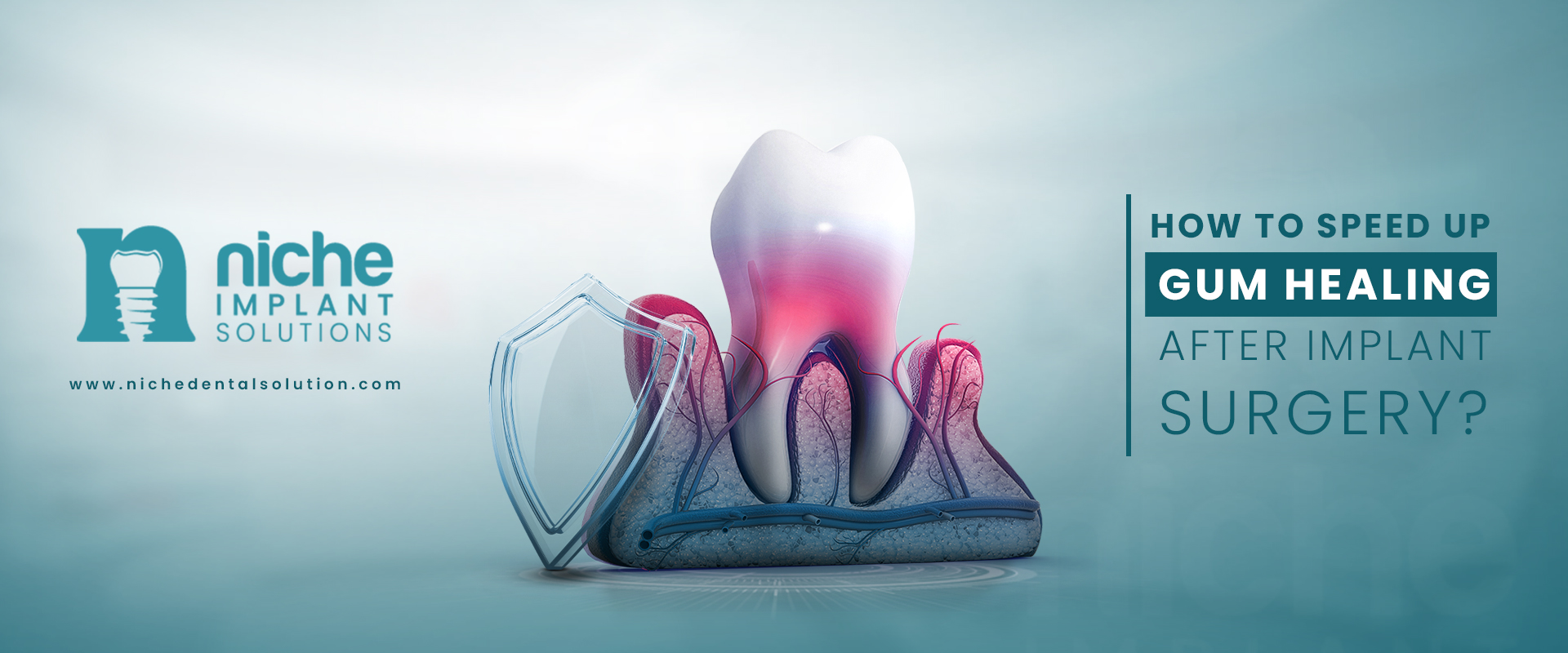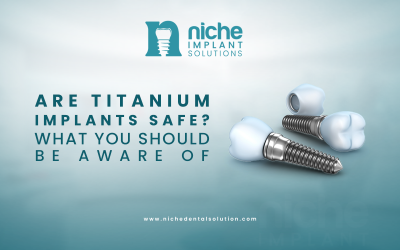A dental implant is a revolutionary solution for replacing missing teeth. We have noticed lately the growth of implant manufacturing companies like Straumann, Zimmer, Megagen and other implant solutions companies like Niche. These small, screw-like posts are surgically placed in your jawbone to act as anchors for artificial teeth. However, achieving a successful implant outcome relies heavily on proper gum healing after implant procedure. In this blog, we will dive deep into everything you need to know about gum healing after implants, including the process, timeline, tips for optimal recovery, and potential complications.
What happens to gum after a dental implant?
Dental implant surgery involves creating an opening in the gum tissue to place the implant post in the jawbone. Naturally, your gums will experience some trauma and inflammation following this procedure. Luckily, the human body is remarkably adept at healing. Firstly you should know that gum healing after implant will go through a two-phase healing process
Phase 1: Implant Placement and Osseointegration (3-6 Months)
- Initial Healing (1-2 Weeks): The focus here is on forming a blood clot and preventing infection. Your gums will likely be a bit sore and inflamed, but this should subside within a few days. Your dentist will likely prescribe pain medication and recommend a soft food diet to minimize pressure on the implant site. It’s important to avoid brushing directly on the implant area during this time.
- Osseointegration (3-6 Months): This is the key phase where your jawbone fuses with the implant post. While the bone is doing the heavy lifting, your gums play a supporting role. They’ll gradually form a tight seal around the implant, creating a stable foundation. You can slowly return to a normal diet during this time, but avoid very hard or chewy foods.
Phase 2: Abutment Placement and Crown Restoration (1-2 Weeks)
- Minor Surgery: Once osseointegration is complete, a minor procedure is needed to expose the implant and place the abutment (the connector between implant and crown). This can cause some minor gum irritation, but healing is usually quick.
- Final Healing and Crown Placement (1-2 Weeks): The gums will heal around the abutment, forming a final tight seal. Once completely healed, the dentist will attach the permanent crown, completing the dental implant restoration.
Factors Affecting Gum Healing After Implants
The speed and quality of gum healing after implant surgery depend on several factors, which can influence how quickly and effectively your gums heal after dental implant surgery. Here’s a breakdown of some key influences:
Surgical Technique and Complexity of the Procedure:
A skilled and experienced dentist using minimally invasive techniques can promote faster and smoother healing. Also more complex implant procedures may require additional steps like bone grafting. These procedures can involve more extensive gum manipulation and may take longer for the gums to heal completely.
Patient Health:
Underlying health conditions can play a role. Conditions like diabetes or a compromised immune system can slow down healing because they can make your body less efficient at fighting infection and repairing tissues. And also they can slow down gum healing after implant and increase the risk of complications.
Oral Hygiene Habits:
Maintaining good oral hygiene is critical for optimal gum healing. Brushing and flossing regularly removes plaque and bacteria, which can hinder healing and increase the risk of infection. Poor oral hygiene can lead to inflammation and potentially implant failure.
Smoking:
Smoking is a major deterrent to healthy gum healing. Smoking constricts blood vessels, reducing blood flow to the implant site, which can slow down healing and increase the risk of complications like peri-implantitis (infection around the implant).

Type of Implant Procedure:
Certain procedures, like immediate implant placement after tooth extraction, might involve longer healing times compared to traditional implant placement. Also the types and quality of implant and implant solutions which should be high quality like Ti-bases of Niche implant solutions company.
By understanding these factors and taking proactive steps to minimize their impact, you can promote optimal gum healing after implant surgery and contribute to a successful outcome.
Also Read: Top Dental Implant Companies in the World: A Comprehensive Guide of Top 20 (2024 Edition)
How to Minimize the Impact of Factors Affecting Gum Healing After Implant Procedures:
Open communication with your dentist by being upfront about any health conditions you have and medications you take. Try to maintain meticulous oral hygiene by following your dentist’s instructions for brushing and flossing around the implant site. Also quit smoking (ideally before surgery and finally follow post-operative instructions carefully that include medication use, dietary restrictions, and any specific cleaning techniques recommended by your dentist.
Timeline for Gum Healing After Implants
Here’s a general timeline for gum healing after implant surgery, but keep in mind this can vary based on individual factors& Remember, everyone heals at their own pace. By following these tips and your dentist’s specific instructions, you’ll be well on your way to a smooth recovery and a healthy smile.
- Week 1-2: You will experience some swelling, discomfort, and minor bleeding.
- Weeks 3-4: The stitches (if any) will be removed, and your gums will start to appear more normal.
- Weeks 6-8: Bone healing begins to occur around the implant.
- 3-6 Months: The gums and jawbone should be fully healed, allowing for the placement of the abutment and crown.
Optimizing Gum Healing After Implant Surgery
Following your dentist’s post-operative instructions is vital for optimal gum healing after implant. Here are some key tips:
Pain Management: Take prescribed pain medication as directed by your dentist. Minimize Swelling: Apply ice packs to the outside of your cheek near the implant site to reduce swelling during the first 24-48 hours. Gently brush your teeth and clean around the implant site using a soft-bristled toothbrush and antibacterial mouthwash as instructed by your dentist.
Diet and rest: Stick to a soft diet for the first few weeks after surgery to avoid putting undue stress on the healing gums. Get plenty of rest to allow your body to focus on healing.
The Importance of Proper Gum Healing for a Thriving Smile
Benefits of Proper Healing: Conclude by emphasizing the importance of proper gum healing for a successful implant outcome and a healthy smile. However, a crucial element for a long-lasting, successful outcome is proper gum healing after implant surgery. Here’s why:
- Strong Foundation: Healthy gum tissue forms a tight seal around the implant, anchoring it firmly in the jawbone. This prevents bacteria from entering and causing infection, which can lead to implant failure.
- Long-Term Stability: Proper healing ensures the implant and surrounding bone integrate seamlessly, creating a stable foundation for the crown. This translates to a beautiful smile that functions flawlessly for years to come.
- Reduced Risk of Complications: When gums heal well, the risk of peri-implantitis (infection around the implant) is significantly reduced. This infection can lead to pain, bone loss, and potentially even implant failure.
- Aesthetic Appeal: Healthy gums contribute to a natural, aesthetically pleasing smile. They frame the teeth and provide a pink, healthy appearance around the implant crown.
- Overall Oral Health: Well-healed gums contribute to overall oral health by preventing the spread of infection and inflammation in the mouth. This keeps your smile not only beautiful but also healthy.
By prioritizing proper gum healing through meticulous post-operative care and following your dentist’s instructions, you’re investing in the longevity and success of your dental implants. This ensures a healthy, stable foundation for your new smile, allowing you to enjoy the confidence and functionality of dental implants for years to come.
Potential Complications After Implant Surgery
While uncommon, some potential complications can arise during gum healing after implant surgery. These include Infection which is a serious complication that can lead to implant failure. Signs of infection include increased pain, swelling, redness, and pus around the implant site.

Minor bleeding:
also is expected after surgery. However, excessive bleeding should be reported to your dentist immediately. During surgery, there’s a slight risk of damaging nerves in the jaw, which can cause numbness or tingling in the surrounding area. This is usually temporary and resolves as healing progresses.
Sinus Issues:
In upper jaw implant placements, there’s a possibility of impacting the sinus cavity, leading to sinusitis symptoms like facial pain, congestion, and runny nose.Implant Failure: In rare cases, the implant may not integrate properly with the jawbone, leading to implant failure. This might require removal of the implant and a new surgery attempt.
When to Call Your Dentist?
If you experience any of the following symptoms after implant surgery, contact your dentist immediately, severe and persistent pain, excessive bleeding, signs of infection (increased swelling, redness, fever, numbness or tingling that worsens or persists, difficulty breathing or swallowing
Dental implant surgery is a safe and effective procedure with a high success rate. However, allowing proper time and care for gum healing after implant placement is crucial for a successful and long-lasting restoration. By understanding the healing process, and the factors affecting it, and following your dentist’s instructions diligently, you can optimize your healing journey and enjoy the benefits of dental implants for years to come.





0 Comments